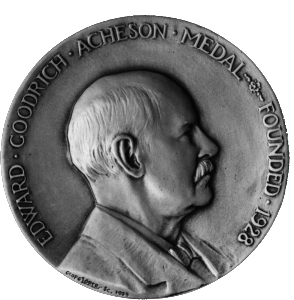 The Edward Goodrich Acheson Award, one of the oldest and most prestigious ECS honors, was established in 1928 for distinguished contributions to the advancement of any of the objects, purposes or activities of The Electrochemical Society. Read the nomination rules.
The Edward Goodrich Acheson Award, one of the oldest and most prestigious ECS honors, was established in 1928 for distinguished contributions to the advancement of any of the objects, purposes or activities of The Electrochemical Society. Read the nomination rules.
The recipient shall be an ECS member who is distinguished for contributions consisting of: (a) discovery pertaining to electrochemical and/or solid state science and technology, (b) invention of a plan, process or device or research evidenced by a paper embodying information useful, valuable, or significant in the theory or practice of electrochemical and/or solid state science and technology.
Did you know that since 1929, ECS has presented the Acheson Award 43 times? Of that number, 33 award winners have also served the organization as President. The most recent recipient of this award was Ralph Brodd in 2014, the 79th ECS President who was esteemed for over 40 years of experience in the battery industry.
Edward Goodrich Acheson (1856 – 1931) was an American chemist and the 6th President of The Electrochemical Society who invented the Acheson process, which is still used to make silicon carbide (carborundum) and later a manufacturer of carborundum and graphite. Acheson worked with Thomas Edison and experimented on making a conducting carbon to be used in the electric light bulb.

